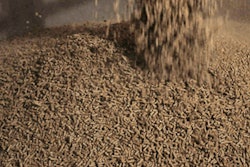Sanderson Farms' chairman, Joe F. Sanderson, Jr., said he is keeping a close eye on operating costs, chicken markets and the U.S. broiler industry’s production numbers in the broiler company’s second-quarter earnings call with stock analysts.
The rising level of broiler egg sets reported by USDA is a concerning economic bellwether, but Sanderson told analysts he doesn’t believe U.S. broiler producers will produce an oversupply of chicken in 2015 to ruin the industry’s profitability.
Incentive for expansion of broiler production
Profitability has been good in the U.S. broiler industry for two consecutive years, and chicken producers are concerned that a rising number of egg sets could over tip current profitability.
Net income for Sanderson Farms in the second quarter of fiscal 2015, for example, was $71.2 million, or $3.13 per share, compared with net income of $51.0 million, or $2.21 per share, for the second quarter of fiscal 2014.
“The results for our second quarter of fiscal 2015 reflect lower grain costs and continued favorable demand for poultry products," Sanderson said. “Our net sales were 8.5 percent higher compared with the second quarter of fiscal 2014, reflecting increased volume offset by slightly lower market prices. Demand for chicken remains strong from our retail grocery store customers and, for the first time since 2008, we are able to say demand at foodservice has improved. Traffic and same store sales at foodservice establishments has improved across most all segments of the industry, aided by lower gasoline prices and improving macroeconomic factors."
Industry anxiety over rising broiler egg sets
This is all very favorable for the profitability of U.S. broiler producers but is the classic recipe for broiler industry overproduction.
“There has been a significant amount of discussion,” Sanderson noted, “one might even say anxiety in the industry regarding the recent increase in pullet placements and what that increase might mean for future chicken supplies.”
Hatcheries in the United States weekly program set 219 million eggs in incubators during the week ending May 23, 2015, up 2 percent from a year ago. Hatcheries in the 19-state weekly program set 210 million eggs in incubators during the week ending May 23, 2015, up 2 percent from the year earlier.
Sanderson said egg sets may rise to 215 to 216 million weekly, which matches the industry’s current capacities in hatching and processing.
Drive for maximum full production
Sanderson Farms executives, nonetheless, made the case in the conference call for why the U.S. broiler industry won’t overproduce headed into 2016.
It won’t be for lack of trying, in fact, if U.S. broiler producers don’t overproduce in 2015, Sanderson indicated. “The industry is trying to get back to maximum full production,” he said.
Sanderson said he believes U.S. broiler producers will process between 3 percent to 4 percent more chickens during 2015, and those birds will be heavier to add another 3 percent to the total amount of pounds of chicken meat processed.
Why U.S. broiler producers won’t overproduce
The chief reason there won’t be overproduction of chicken in 2015, he said, is that the industry will run into a processing capacity ceiling. His rationale is as follows:
- The tranche of post-recession expansions in broiler processing capacity has pretty much wound down except for ongoing expansions of three companies: Wayne Farms, Koch Foods and Sanderson Farms.
- Chicken processors raised broiler weights in 2014 and 2015 about as much as processing and marketing programs and customer mixes will permit.
While the rise in egg sets may indicate the industry is on a path to produce more eggs than the industry’s 215 million to 216 million hatching and processing capacity, Sanderson noted two offsetting factors in play:
- A portion of the U.S. broiler industry’s current egg sets are earmarked for export to Mexico.
- After shortages of hatching eggs in 2014, U.S. broiler producers may in some cases have overbooked orders of primary breeder stock.
Sanderson pointed to the level of weekly egg sets reached in 2007 – 220 million – as a potentially profitable level in 2016, if there is a strengthening in labor markets.
Potential upside in chicken market
“Assuming the industry can produce another 2.5 percent to 3 percent more head of chickens in 2016 before hitting the processing ceiling, it is possible the market can absorb that amount of production [without a decline in prices to below profitable levels],” Sanderson said.
He pointed to the market’s response to the broiler industry’s expansion so far in 2015 as a demonstration of the strength in consumer demand for chicken.
“The macroeconomic improvements this year are primarily because of lower prices gasoline and a slight improvement in employment numbers. Wages however have not improved significantly and labor participation rates remain low. Should those numbers improve in 2016 it is possible increased supply then would not necessarily mean oversupply,” he said.

















